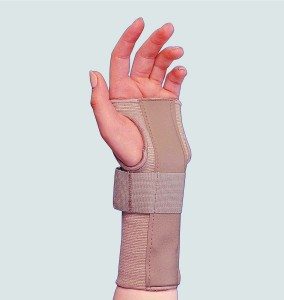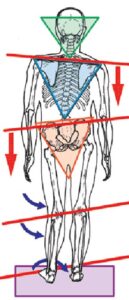 Elbow pain, Wrist pain, Thumb pain, and numbness; the problem with braces, and how to find effective solutions.
Elbow pain, Wrist pain, Thumb pain, and numbness; the problem with braces, and how to find effective solutions.
Many people experience elbow pain, wrist pain, and thumb pain. People are often diagnosed with tendonitis, De Quervain’s tenosynovitis, Carpal Tunnel Syndrome, ulnar entrapment as well as many other conditions. Is this type of diagnosis helpful since the diagnosis does not explain or describe why the condition exists? It also names more the symptom rather than the problem. In a world of symptom-related care, this may make sense however, it does not help you find effective and cost-effective care.
There are many braces that people apply to attempt to resolve or at least relieve conditions such as this. An example is the wrist splint which is often used with Carpal Tunnel Syndrome. The splint is designed to eliminate motion, yet, once the splint is removed, the wrist will likely be sore, weak and painful with usage. The person is also likely to experience other symptoms since the splint works on restricting the painful area, rather than addressing why the area is painful. In the worst cases, a neurologist may order a test called an NCV or nerve conduction velocity test which often tells the healthcare provider little more than a good evaluation would at a lower cost. Tests like these are often used to make a referral that is likely to result in surgery to the symptomatic area which rarely results in a cure but may leave you disabled instead.
While some people report some relief from carpal tunnel surgery, others develop other problems with this such as a permanently weak grip, problems along the upper kinetic chain (series of joints from the wrist, to the elbow to the shoulder), and other symptoms in the arm and shoulder. You can understand this better by reading Cheating Mother Nature, what you need to know to beat chronic pain which describes in easy-to-read concepts why the condition occurs and what you as a healthcare consumer do about it.
A better way to resolve your problems in the hand, wrist, and hand numbness.
A more healthy way to look at the conditions of the arm is to understand why your arm, elbow, or wrist would hurt and why you are experiencing numbness. Most often, a thorough musculoskeletal evaluation is more helpful than expensive tests such as the NCV because many of these problems in the arm are secondary to malfunctions in the lower part of the body.
The most common reason people experience problems in the shoulder, wrist, and elbow has to do with body style or posture, which begins at the feet. The more that the feet turn out or toe out, the more the shoulder rolls in. Also, low arches or flat feet have a similar effect. Rothbart calls this bio-implosion which causes the shoulders to roll forward. When the shoulders roll forward, they no longer function properly, the body does not distribute forces properly, and we lose external rotation in the arms which stresses the elbows, wrist, and thumb and with repeated usage, develops tightness in the myofascia (connective tissues surrounding the muscles and nerves), which develops into nerve entrapments, tight forearms, strained joints, and pain.
 When this happens asymmetrically, the problems created in the pelvis (tortipelvis), distort the core section responsible for how we distribute forces throughout the body as we walk and perform athletics, which also distorts the rib cage giving rise to problems in the arms, and also shoulder and neck pain due to tension on the shoulders.
When this happens asymmetrically, the problems created in the pelvis (tortipelvis), distort the core section responsible for how we distribute forces throughout the body as we walk and perform athletics, which also distorts the rib cage giving rise to problems in the arms, and also shoulder and neck pain due to tension on the shoulders.
Holistic thinking and active evaluation and treatment
A better mainstream approach is available, and many therapists as well as sports chiropractors are employing an idea called active evaluation and treatment. Rather than just looking at the problem, calling it and itis or a syndrome, and then injecting, medicating it, or bracing it, or as we see in most athletes now taping it, many healthcare providers are using a protocol of treat-test-treat. The reason this is more effective is that when an area improves and fires (coordinates motion) properly, strength is restored, we avoid using the wrong muscular areas which is why we tighten up and our bodies function better.
Taking this idea one step further, doctors who are holistic in their thinking will take your history, look at your body mechanics, and then connect the dots so you and they can better understand your problem before proceeding with a planned method of treatment. This is important because it greatly reduces treatment times because the treatment is most likely to be appropriate for the condition being treated. Instead of doing stuff to it, they are understanding the mechanism of your problem and working backward to resolve the mechanism.
To understand this idea further, and to help you best find those who are capable of helping you figure out your problem, read Cheating Mother Nature, What You Need to Know to Beat Chronic Pain which is available through Amazon.com and other major booksellers.
Keep things simple for the best results.
A coordinated plan of treatment, the use of shoe inserts and muscular treatments such as Active Release Techniques (r), Graston Technique, and Myofascial Release combined with exercises and chiropractic extremity manipulation can resolve most upper body pain problems such as wrist, elbow, and shoulder pain and even nerve entrapments without the use of drugs or surgery. The treatments alone are effective but by using the right thought process and understanding the kinetic chain malfunction correctly, most patients can avoid costly, disabling, and risky drugs, surgeries, and rehab plans that cannot possibly work since they show a lack of understanding of the causation of the condition they are designed to treat.
This idea of active evaluation personalizes the care since no two people are exactly alike mechanically, and to truly resolve mechanical problems, your healthcare practitioner must fully understand why your problem exists and evaluate you, not just your symptoms. Most people do not require surgery for these types of problems, and many of these surgeries are of little benefit, since they may increase your risk of other problems in the back, shoulder, and even neck region since the symptom was addressed, rather than the problem.
A sports chiropractor is likely your best first choice for primary care of the musculoskeletal system. Problems in the wrist, arm, and elbow do not require a surgical specialist in most cases, they require a thorough diagnosis and treatment of the mechanism behind why you hurt. They require a holistic point of view which is offered by today’s sports chiropractor.
Do you need help now? Book online here